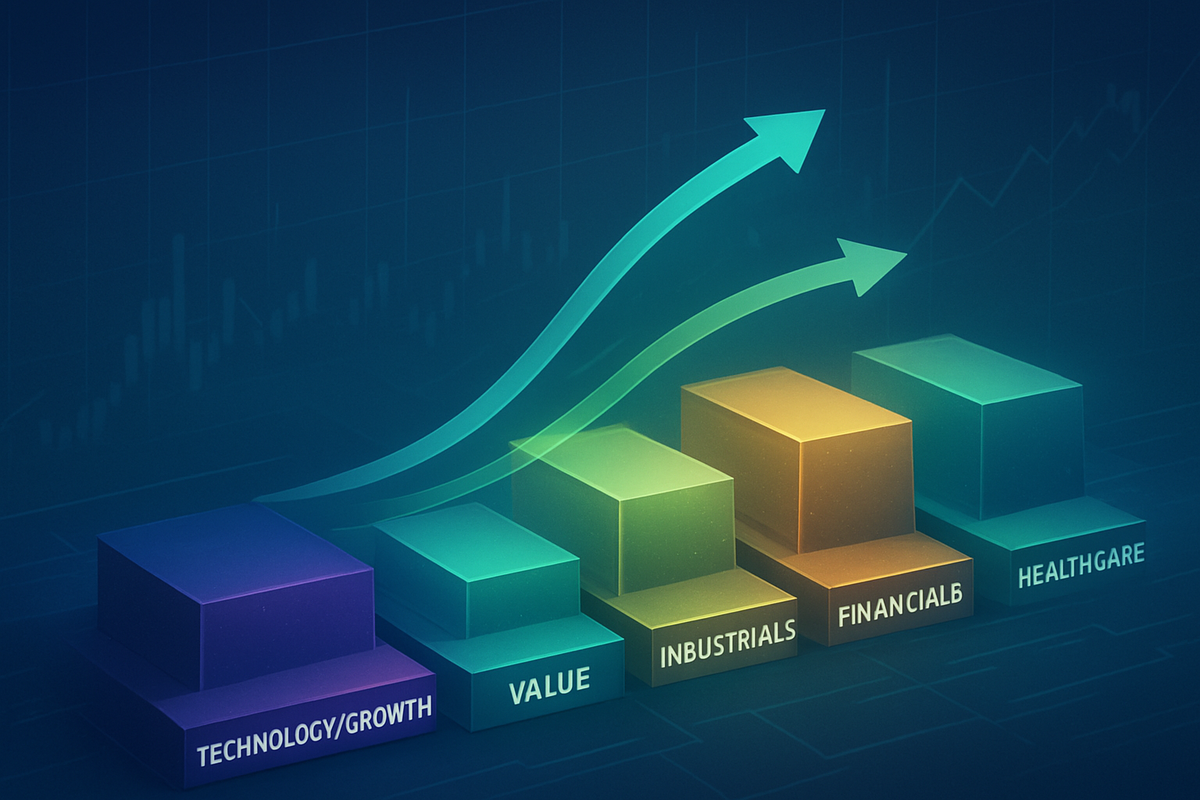Financial News
Smart Money Shifts Gears: Navigating the Great Sector Rotation of 2025

As the calendar turns to November 2025, financial markets are witnessing a pivotal shift, with "smart money" actively rebalancing portfolios away from the high-flying growth and technology stocks that have dominated for years. This significant sector rotation is driven by a complex interplay of moderating economic growth, persistent yet easing inflationary pressures, and a delicate dance of interest rate adjustments by global central banks. The immediate implication for investors is a heightened need for diversification and a keen eye on undervalued opportunities, as market leadership broadens beyond a handful of tech giants.
The current environment signals a "risk-off" sentiment impacting global financial markets, with capital moving into more undervalued and cyclical sectors. Earnings estimates are on the rise across a broader spectrum of the S&P 500 sectors, indicating a healthier market breadth. This suggests that profit growth is becoming more widespread, moving beyond the concentrated performance previously seen in technology. The period from November through April is historically favorable for cyclical sectors such as consumer discretionary, industrials, and materials, which are now gaining traction.
Unpacking the Market's Rebalancing Act
The current sector rotation is a multifaceted phenomenon, characterized by a pronounced shift from previously dominant growth and technology stocks towards value, cyclical, and defensive sectors. This rebalancing intensified around August 2025, driven by the anticipation of the Federal Reserve's first interest rate cut of the year. Defensive sectors like Utilities and Healthcare (XLV) have seen a turnaround, reporting stronger-than-expected earnings in the first half of 2025. Value-oriented sectors such as Financials, Industrials (XLI), Energy, and Materials are also gaining momentum, with regional banks like PNC Financial Services Group (NYSE: PNC) and JPMorgan Chase (NYSE: JPM) poised to capitalize on stable net interest margins and potential M&A activity. The energy sector, particularly in traditional oil services and those building renewable divisions, presents a bifurcated opportunity.
The timeline of this rotation shows a gradual improvement in market breadth from late 2024, followed by a pivotal moment in early 2025 when the Federal Reserve paused rate hikes and inflation data consistently surprised to the upside. April 2025 saw tariffs and evolving U.S. trade policy trigger a sharp market crash and a rotation towards defensive, value-sensitive industries. By early November 2025, the rotation is intensifying, with investors securing profits from growth-oriented equities like biotechnology and AI, reallocating capital. A notable sell-off on November 4th saw the Nasdaq drop 1.80% and the S&P 500 fall 1.11%, heavily impacting technology and small-cap stocks, wiping over $500 billion from leading AI chipmakers.
Key players orchestrating and reacting to this shift include the Federal Reserve and other central banks, whose evolving monetary policies are the linchpin of equity market dynamics. Institutional investors and fund managers are actively rebalancing portfolios, moving capital from previously overvalued growth assets. Market strategists and analysts from firms like BlackRock and Raymond James are providing guidance, while advanced AI-driven platforms are increasingly used to pinpoint early signs of momentum. Initial market reactions have been characterized by heightened volatility, profit-taking in tech, and a notable resilience in value and defensive sectors, along with a broadening of market participation.
Winners and Losers in the Shifting Tides
The ongoing sector rotation is creating clear winners and potential losers among public companies, demanding selective investment strategies focused on micro-level details and specific company fundamentals.
Companies positioned to win include those enabling Artificial Intelligence Infrastructure & Application, despite valuation scrutiny. NVIDIA (NASDAQ: NVDA), a leader in AI chips, continues to benefit from massive capital expenditure in AI. Microsoft (NASDAQ: MSFT), with its Azure cloud platform and AI-integrated software, is also a major beneficiary. Their entrenched positions and continuous innovation keep them at the forefront. The Defense and Aerospace sector is also thriving due to increased global defense spending. Companies like Lockheed Martin (NYSE: LMT) and RTX Corporation (NYSE: RTX) are direct beneficiaries of robust defense budgets and long-term government contracts. Regional Banks and Financials, such as PNC Financial Services Group (NYSE: PNC) and JPMorgan Chase (NYSE: JPM), are set to gain from anticipated lower interest rates and potential deregulation, which could spur M&A activity. The Healthcare sector, particularly those integrating AI, like UnitedHealth Group (NYSE: UNH) and Intuitive Surgical (NASDAQ: ISRG), is expected to show resilience and innovation. Finally, Energy and Utilities, specifically in renewables and power infrastructure, are benefiting from AI's immense energy demands and the ongoing energy transition. NextEra Energy (NYSE: NEE) and Constellation Energy (NASDAQ: CEG) are well-positioned in this space.
Conversely, certain sectors and companies are positioned to lose. Commercial Real Estate (Office & Certain Multifamily REITs) faces significant headwinds due to rising delinquency rates on commercial mortgage-backed securities (CMBS) and negative impacts on rental markets. Major office REITs like Vornado Realty Trust (NYSE: VNO) could suffer from lower occupancy and declining rental income. While cyclicals are generally attractive, Industrials (Highly Cyclical without Strong Backlogs) warrant caution due to expected economic deceleration. Companies like Caterpillar Inc. (NYSE: CAT), a bellwether for global economic activity, and 3M Company (NYSE: MMM), with its exposure to various industrial markets, could face reduced demand. Lastly, Overvalued, Non-AI-centric Growth Technology companies, especially those with high burn rates or lacking a clear AI integration strategy, may struggle as investors prioritize profitability and shift away from "growth at any cost" models.
The Broader Implications of a Shifting Landscape
This current sector rotation is more than just a momentary market fluctuation; it fits into broader industry trends, signaling a maturing economic cycle and a re-evaluation of investment fundamentals. The shift away from concentrated tech leadership towards a broader market rally indicates a healthier, more diversified economy. It underscores the cyclical nature of markets, where different sectors are favored during distinct phases of the business cycle. The service sector's strong expansion and broadening profit growth across S&P 500 sectors further support this narrative, suggesting a move away from a mid-cycle slowdown.
The ripple effects are widespread. Technology and growth companies that thrived on high valuations may face increased scrutiny and reduced capital. Conversely, companies in value and defensive sectors could see increased investment, potentially leading to improved access to capital for expansion. The sustained demand for AI infrastructure, particularly GPU cloud instances, presents new opportunities for cloud service providers and hardware manufacturers, fostering partnerships focused on efficient AI deployment. Small-to-medium businesses may also benefit from potential tariff reductions, alleviating cost pressures and spurring job growth. A rotation out of the "Magnificent Seven" tech giants could have widespread market effects due to their significant influence.
Regulatory and policy implications are also profound. The US presidential election in early 2025, leading to a Republican-controlled administration, has introduced policy uncertainty impacting investor behavior. The increasingly complex regulatory environment, especially concerning technology, is affecting M&A in the tech sector, leading to longer approval timelines and increased diligence burdens. AI-specific regulations, such as the EU AI Act, are mandating transparency and risk management, directly impacting companies commercializing AI solutions. The Federal Reserve's current stance of lowering short-term rates is a significant policy driver influencing capital rotation towards undervalued sectors. Historically, major macroeconomic events like the DotCom Bubble burst in the early 2200s and the 2008 financial crisis have demonstrated how market leadership can dramatically shift, emphasizing the cyclical nature of sector performance.
Charting the Course Ahead: Opportunities and Challenges
The path forward is characterized by both short-term volatility and long-term structural shifts. In the short term (late 2025 - early 2026), continued market volatility is expected, but underlying investor confidence, evidenced by record cash in money market funds, suggests that market dips are likely to be bought. Portfolio rebalancing will persist, favoring cyclical and defensive sectors like financials, industrials, and materials, while the technology sector may experience consolidation. Geopolitical risks, trade policies, and inflation will maintain high market volatility. Smaller-cap stocks, particularly in technology, healthcare, and industrials, could see renewed interest.
Long-term (2026-2027 and beyond), the market is expected to become more balanced, reducing its reliance on a few mega-cap technology companies. Volatility may become the "new normal," requiring continuous adaptation. The global economy is projected to slow but maintain underlying resilience. Transformative technologies, especially AI, and evolving global supply chains will create significant long-term opportunities. Earnings growth is forecast to broaden beyond tech, leading to continued rotation into undervalued sectors. AI investment in infrastructure, data centers, and semiconductors is predicted to be a dominant theme, propelling global economic growth.
To navigate these trends, strategic pivots are crucial. Diversification across asset classes, geographies, and investment styles is paramount. Active management and quality investing, prioritizing companies with robust balance sheets, are advisable. Regular portfolio rebalancing and the implementation of sector rotation strategies are essential. Investors should consider alternative investments like private equity, real estate, and commodities, and maintain larger cash positions. Leveraging AI-driven tools can provide early insights into market momentum. A barbell strategy, balancing growth with defensive assets, and a focus on U.S. large-cap equities, particularly in financials, utilities, and technology, are also recommended.
Market opportunities include attractive entry points for undervalued assets during pullbacks, particularly in U.S. equities. Defensive and international exposure, gold, and bonds offer stability and growth. Thematic growth in AI, private markets, renewable energy, and cybersecurity are key areas. Challenges include geopolitical risks, valuation sensitivity in some sectors, continued volatility, and the possibility of stagflation. Unpredictable economic cycles and persistent inflation also pose risks.
The Enduring Impact of a Market in Motion
The current sector rotation is a powerful reminder of the cyclical nature of financial markets, emphasizing that sustained outperformance by any single sector or investment style is rarely permanent. This shift signifies a return to more traditional, economic cycle-based investing, where different sectors naturally assume leadership roles at various stages of the business cycle. The increasing sophistication of AI-driven analytical tools is also fundamentally transforming how investors approach sector rotation, enabling more precise and data-informed decisions.
Moving forward, the market is likely to deliver positive returns over the longer term, but with a "choppy but resilient" trajectory. The lasting impact will be a renewed emphasis on diversification across sectors, market capitalizations, and investment styles. Active management, informed by a deep understanding of economic cycles and sector-specific catalysts, will be critical for optimizing portfolios. The broadening of market leadership, moving beyond a narrow group of tech giants, will foster a healthier and more resilient economic landscape.
Investors in the coming months should closely monitor economic indicators for clues about the business cycle, pay keen attention to the Federal Reserve's interest rate outlook, and track developments in tariff and trade policies. Scrutinizing earnings growth and valuations to identify fundamentally sound businesses in undervalued sectors is vital. Utilizing technical and momentum indicators can help pinpoint emerging sector strength. While the core AI rally may be priced in, keeping an eye on long-term thematic investment evolution in areas like renewable energy and AI-driven automation remains crucial. Finally, observing market breadth will indicate whether the rally continues to broaden, signaling a more diversified uptrend. While volatility presents risks, it also creates opportunities for agile investors.
This content is intended for informational purposes only and is not financial advice
More News
View More




Recent Quotes
View More
Quotes delayed at least 20 minutes.
By accessing this page, you agree to the Privacy Policy and Terms Of Service.



